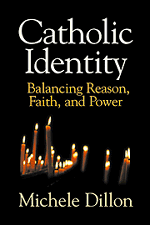Book contents
- Frontmatter
- Contents
- Acknowledgments
- 1 Pro-Change Catholics: Forging Community out of Diversity
- 2 Doctrinal Change in the Catholic Church
- 3 Official Church Teaching on Homosexuality, Women's Ordination, Abortion, and the Role of the Theologian
- 4 Pro-Change Groups in the Contemporary Church: Dignity, the Women's Ordination Conference, and Catholics for a Free Choice
- 5 Gay and Lesbian Catholics: “Owning the Identity Differently”
- 6 Using Doctrine to Critique Doctrine
- 7 Pluralism in Community
- 8 Reasoned Theology: Legitimating Emancipatory Possibilities
- 9 Catholic Options
- Appendix: Research Methodology
- References
- Index
2 - Doctrinal Change in the Catholic Church
Published online by Cambridge University Press: 04 August 2010
- Frontmatter
- Contents
- Acknowledgments
- 1 Pro-Change Catholics: Forging Community out of Diversity
- 2 Doctrinal Change in the Catholic Church
- 3 Official Church Teaching on Homosexuality, Women's Ordination, Abortion, and the Role of the Theologian
- 4 Pro-Change Groups in the Contemporary Church: Dignity, the Women's Ordination Conference, and Catholics for a Free Choice
- 5 Gay and Lesbian Catholics: “Owning the Identity Differently”
- 6 Using Doctrine to Critique Doctrine
- 7 Pluralism in Community
- 8 Reasoned Theology: Legitimating Emancipatory Possibilities
- 9 Catholic Options
- Appendix: Research Methodology
- References
- Index
Summary
The efforts of pro-change Catholics in moving the church toward a greater affirmation of diversity inevitably dispute some of the taken-for-granted doctrines and practices that appear as core to the church's public identity. In particular, the Catholic Church presents an image of a divinely prescribed hierarchical institution whose teaching is constant and immutable. Yet from an historical perspective it is evident that change in doctrines and practices has been a feature of the church since earliest times. Accordingly, the boundaries of Catholicism and what is core to the tradition, are less rigid than might be assumed from the image of an immutable church that is presented in official church accounts and frequently perceived as such by Catholics and non-Catholics alike (cf. O'Malley 1989: 15–16).
The Catholic theologian Yves Congar argued that there is a tendency for the church hierarchy “to regard itself as a source” of revelation and to present itself as identical to rather than an interpreter of the Catholic faith tradition (1967: 336–337). The church hierarchy's tendency to identify itself as a “source” of doctrine makes it difficult for it to explicitly acknowledge that doctrine changes and that church structures, including official understandings of the church hierarchy's authority, are mutable. The church hierarchy seeks to bolster its own authority and what it considers to be the essential structure of the church by appealing to a “constant” tradition which has “always taught” that certain doctrines and organizational forms are fundamental to the identity and functioning of the church.
- Type
- Chapter
- Information
- Catholic IdentityBalancing Reason, Faith, and Power, pp. 34 - 53Publisher: Cambridge University PressPrint publication year: 1999



